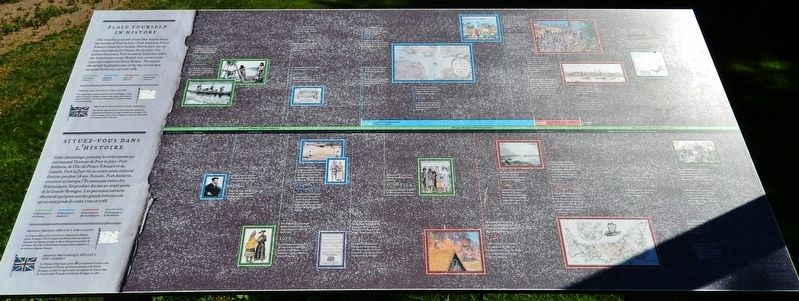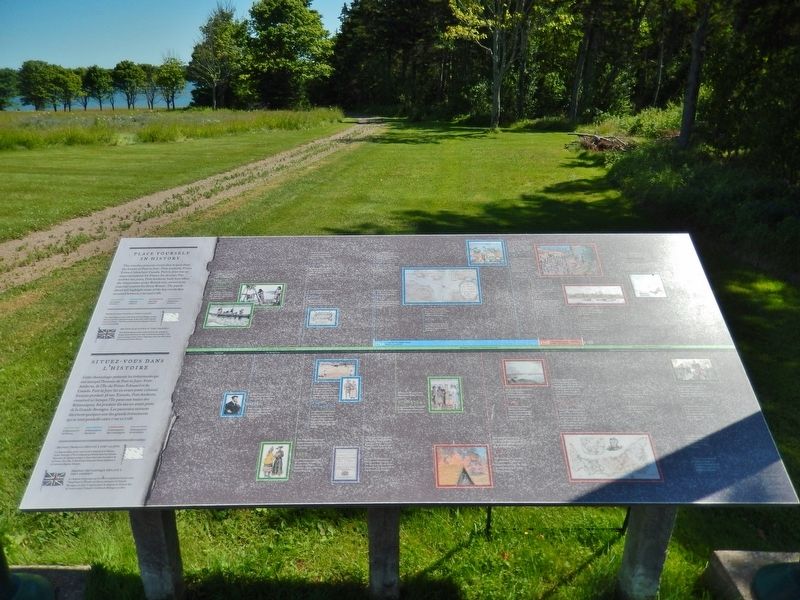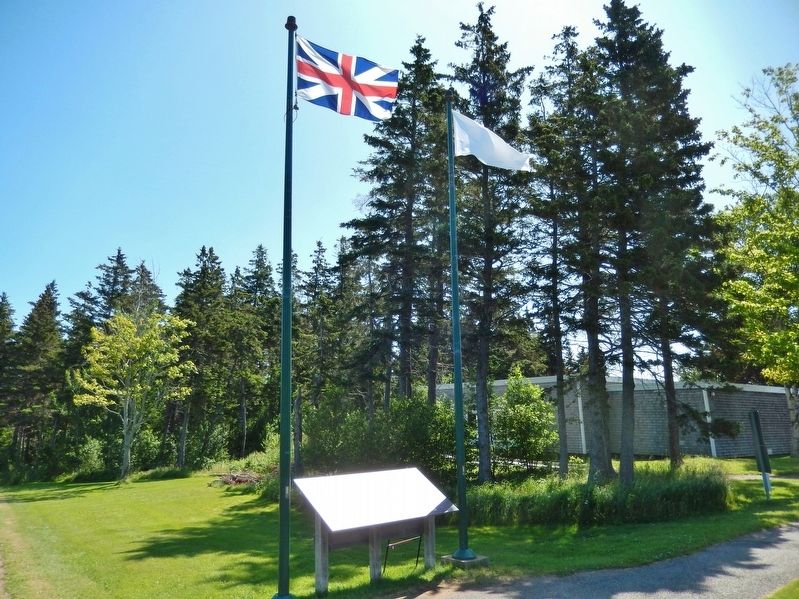Rocky Point in Queens County, Prince Edward Island — The Atlantic Provinces (North America)
Place Yourself in History / Situez-vous dans l’histoire
Inscription.
This timeline presents events that helped shape the history of Port-la-Joye—Fort Amherst, Prince Edward Island and Canada. Port-la-Joye was an imperial outpost for France for 38 years. For another ten years, Fort Amherst, built here when the Island came under British rule, served as an imperial outpost for Great Britain. The panels ahead will highlight some of the key events that occurred between 1720 and 1768.
French Flag Flown at Port-la-Joye
The white flag seen here is the French Naval Ensign. It was flown in French colonies because, at the time, white was the colour of France. The French Revolution (1789) gave France a new national flag.
British Flag Flown at Fort Amherst
The British flag seen here resulted from the uniting of England and Scotland in 1606 to form Great Britain. The current design of the Union Flag dates from the 1801 union of Ireland and Great Britain.
From Time Immemorial • The Mi’kmaq have lived here for thousands of years. They call the Island Epekwitk, which means “lying on the water.”
1534 • Jacques Cartier is the first European to visit the Island, soon called Île Saint-Jean.
1600s • Île Saint-Jean is visited seasonally by Europeans, who come for the off-shore fishery.
1605 • The French establish Port Royale in what is today Nova Scotia.
1610 • The Mi’kmaq begin to adopt Roman Catholicism. A shared religion reinforces ties with the French.
1630s • Continuous French settlement begins in Acadie, or Acadia (mainland Nova Scotia). These French colonists gradually develop a distinctive Acadian identity.
1713 • The Treaty of Utrecht gives Acadia to the British and Île Saint-Jean (Prince Edward Island) and Île Royale (Cape Breton Island) to the French.
1719 • Louis Hyacinthe Castel, Comte de Saint Pierre, is granted land and fishing rights to settle Île Saint-Jean.
1720 • French and Acadians settle on Île Saint-Jean. Port-la-Joye becomes the capital.
1726-1744 • Mi’kmaq and French leaders meet at Port-la-Joye to renew close ties.
1732 • French entrepreneur Jean-Pierre Roma established Trois Rivières, which becomes a significant trade centre.
1745 • After capturing Louisbourg, New England soldiers come to Île Saint Jean and burn Port-la-Joye and Trois-Rivières.
1749 • The British establish Halifax, the French re-occupy
Louisbourg and Port-la-Joye. Imperial rivalry intensifies.
1755 • Thousands of Acadians migrate to Île Saint-Jean before the Deportation begins in Nova Scotia. Between 6000 and 7000 Acadians are deported to Anglo-American colonies. Another 4000 flee.
1758 • After capturing Louisbourg, British forces take over Port-la-Joye. They construct Fort Amherst, the new capital, and the Island is renamed St. John’s Island. Mass deportation of Acadians and French from the Island begins.
1760s • Engineer Samuel Holland surveys the Island, dividing it into 67 lots. In 1767, a lottery is held in England and the Island’s 67 lots are given away. Island residents become tenants on land now owned by absentee landowners.
1768 • The British establish Charlottetown as the capital of St. John’s Island, replacing Fort Amherst.
1799 • St. John’s Island is renamed Prince Edward Island.
1867 • Canada is created with four provinces: Nova Scotia, New Brunswick, Quebec and Ontario.
1873 • Prince Edward Island joins Canada. The federal government soon ends the system of absentee landholding.
1884 • The Acadian flag and national anthem, “Ave Maris Stella” are adopted at the second Acadian National Convention, held in Miscouche, Prince Edward Island.
1967 • Port-la-Joye—Fort
Amherst becomes a national historic site.
Cette chronologie présente les événements qui ont marqué l'histoire de Port-la-Joye—Fort-Amherst, de l'Île-du-Prince-Édouard et du Canada. Port-la-Joye fut un avant-poste colonial français pendant 38 ans. Ensuite, Fort Amherst, construit ici lorsque l'Île passa aux mains des Britanniques, fut pendant dix ans un avant-poste de la Grande-Bretagne. Les panneaux suivants décrivent quelques-uns des grands événements qui se sont produits entre 1720 et 1768.
Drapeau Français déployé à Port-la-Joye
Le drapeau blanc qu'on voit ici est le drapeau de la Marine royale française. C'est le drapeau qui flottait dans les colonies françaises de l'époque puisque le blanc était alors la couleur de la France. En 1789, la Révolution française donna naissance à un nouveau drapeau français.
Drapeau Britannique déployé à Fort Amherst
Le drapeau britannique qu'on voit ici représente l'union entre l'Angleterre et l'Écosse qui donna naissance à la Grande-Bretagne, en 1606. L'aspect actuel du drapeau de l'Union date de l'union entre l'Irlande et la Grande-Bretagne, en 1801.
Depuis la Nuit des Temps • Le Mi’kmaq sont ici depuis des millénaires. Ils appellent l’Île Epekwitk, ce qui veut dire « posée sur l’eau ».
1534 • Jacques Cartier est le premier Européen à poser le pied sur l’Île qui s’appellera bientôt Île Saint-Jean.
Années 1600 • Des Européens s’installent à l’Île Saint-Jean à la belle saison, attirés par la pêche en haute mer.
1605 • Les Français fondent Port-Royal, dans ce qui est aujourd’hui la Nouvelle-Écosse.
1610 • Les Mi’kmaq commencent à se convertir au catholicisme romain. Une religion commune renforce leurs liens avec les Français.
Années 1630 • La colonisation française permanente commence in Acadie (Nouvelle-Écosse continentale). Ces colons français forgeront peu à peu une identité acadienne bien distincte.
1713 • Le traité d’Utrecht donne l’Acadie aux Britanniques, et l’Île Saint-Jean (Île-du-Prince-Édouard) et l’Île Royale (Île du Cap-Breton) aux Français.
1719 • Louis Hyacinthe Castel, comte de Saint-Pierre, obtient des terres et des droits de pêche pour coloniser l’Île Saint-Jean.
1720 • Des Français et des Acadiens s’installent à l’Île Saint-Jean. Port-la-Joye en devient la capitale.
1726-1744 • Le chefs mi’kmaq et français se rencontrent à Port-la-Joye pour renouer des liens étroits.
1732 • L’entrepreneur Jean-Pierre Roma fonde Trois-Rivières, que devient un poste de traite important.
1745 • Après avoir pris Louisbourg, des soldats de la Nouvelle Angleterre arrivent à l’Île Saint-Jean et brûlent Port-la-Joye et Trois-Rivières.
1749 • Les Britanniques fondent Halifax, les Français réoccupent Louisbourg et Port-la-Joye. Les rivalités impérialistes entry les deux pays s’intensifient.
1755 • Des milliers d’Acadiens migrent vers l’Île Saint-Jean avant le début de la Déportation en Nouvelle-Écosse. Entre 6000 et 7000 Acadiens sont déportés vers les colonies anglo-américaines. Quelque 4000 autres s’enfuient.
1758 • Après avoir pris Louisbourg, les forces britanniques prennent Port-la-Joy. Ils construisent Fort Amherst, la nouvelle capitale, et l’Île est rebaptisée St. John’s Island. Commence alors une déportation massive des Acadiens et des Français de l’Île.
1760s • L’ingénieur Samuel Holland arpente l’Île et la divise en 67 lots. En 1767, en Angleterre, on attribue ces 67 lots par tirage au sort. Les résidents de l’Île deviennent donc les occupants de terres appartenant a des propriétaires absents.
1768 • Les Britanniques fondent Charlottetown, qui devient la capitale de St. John’s Island, à la place de Fort Amherst.
1799 • St. John’s Island est rebaptisée Prince Edward Island (Île-du-Prince-Édouard).
1867 • Naissance du Canada, composé de quatre provinces : la Nouvelle Écosse, le Nouveau-Brunswick, le Québec et l’Ontario.
1873 • L’Île-du-Prince-Édouard se joint au Canada. Le gouvernement fédéral met bientôt fin au système des propriétaires absents.
1884 • Adoption du drapeau acadien et de l’hymne national « Ave Maris Stella », lors de la deuxième Convention nationale acadienne, tenue à Miscouche, à l’Île-du-Prince-Édouard.
1967 • Port-la-Joye—Fort Amherst devient un lieu historique national.
Topics. This historical marker is listed in these topic lists: Colonial Era • Forts and Castles • Native Americans • Settlements & Settlers.
Location. 46° 11.739′ N, 63° 8.154′ W. Marker is in Rocky Point, Prince Edward Island, in Queens County. Marker can be reached from Hache Gallant Drive, 1.2 kilometers east of Prince Edward Island Route 19, on the left when traveling east. Marker is located along the walkway, just north of the visitor center, at Skmaqn–Port-la-Joye–Fort Amherst National Historic Site. Touch for map. Marker is at or near this postal address: 191 Hache Gallant Drive, Rocky Point PE C0A 1H2, Canada. Touch for directions.
Other nearby markers. At least 8 other markers are within walking distance of this marker. Michel Haché-Gallant et Anne Cormier (a few steps from this marker); The Deportation of the Inhabitants of Île Saint-Jean (within shouting distance of this marker); The Mi'kmaq / Les Mi'kmaq (within shouting distance of this marker); Port-la-Joye – Fort Amherst (within shouting distance of this marker); Port of Entry / Port d’entrée (within shouting distance of this marker); The British Period / La période britannique (about 150 meters away, measured in a direct line); A Great Survey / Un Arpentage de Taille (about 150 meters away); The Grand Dérangement (about 150 meters away). Touch for a list and map of all markers in Rocky Point.
Related markers. Click here for a list of markers that are related to this marker. Skmaqn–Port-la-Joye–Fort Amherst National Historic Site
Credits. This page was last revised on November 22, 2020. It was originally submitted on June 23, 2020, by Cosmos Mariner of Cape Canaveral, Florida. This page has been viewed 181 times since then and 17 times this year. Photos: 1, 2, 3. submitted on June 27, 2020, by Cosmos Mariner of Cape Canaveral, Florida.


